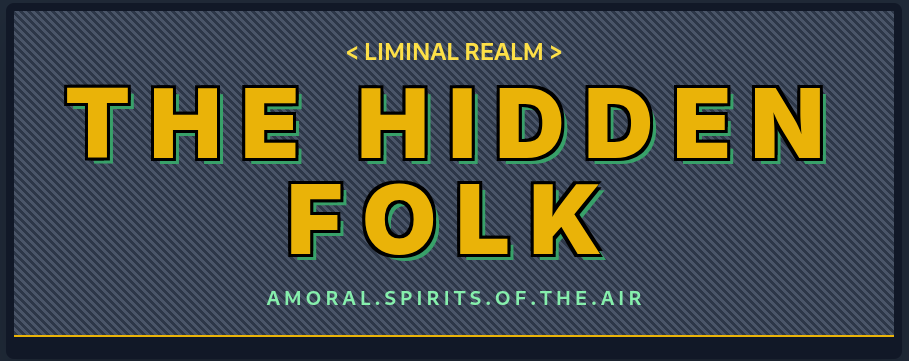
The Hidden Folk
An Examination of the Fae in Old Tales and Ancient Thought
I. Etymology and Historical Origins
The term "Fae" is a broad umbrella for supernatural, often human-like beings whose mythology is a conflation of disparate sources across centuries and continents.
Cultures and Timelines
- Celtic (Medieval to Present): Ireland, Scotland, and Wales hold the deepest tradition. The Daoine Sídhe (People of the Mound) are often linked to the ancient Tuatha Dé Danann (pre-Christian deities) who retreated underground.
- Germanic/Norse (Early Middle Ages): Concepts like Elves (álfar) and certain water spirits (Nix or Neck) heavily influenced the northern European fae tradition.
- Classical (Ancient Greece): Spirits like Nymphs (associated with water, trees, mountains) and Satyrs show early forms of nature deities blended into the "fae" category.
- Persian (Antiquity): The angelic Peris (often described as being caught between heaven and earth) are noted by some historians as a potential influence on European fae lore.
Linguistic and Cultural Theories
The English word "Fairy" derives from the Old French fae (a woman skilled in magic) and faerie (the state of enchantment or their realm), which traces back to the Latin Fata (fate or destiny).
Key Theorical Origins:
Demoted Angels: A Christian folk theory states the Fae are angels who rebelled against God, but weren't evil enough for Hell, nor pure enough for Heaven, leaving them trapped in the middle realms (often the air).
Nature Spirits: They are seen as the literal personification of natural forces, such as dangerous rivers or forest guardians, requiring respect and appeasement.
Prehistoric Race: The idea that the Fae are the remnants of a short, indigenous people who retreated into burial mounds and hills after being conquered by later human settlers.
II. Structured Description of Fae
Folkloric Fae are overwhelmingly amoral, not "good" or "evil." Their actions are governed by alien social codes, often rewarding hospitality and fiercely punishing offenses.
Classification by Court (Scottish/Irish)
The Seelie Court
The "Blessed" or "Fortunate" court. They are generally benevolent toward humans, but still flighty and dangerous if slighted. Often seen as the aristocracy of the Fae world.
The Unseelie Court
The "Unholy" or "Unfortunate" court. These Fae are actively and inherently malicious, requiring no prior offense to cause harm. They include figures that torment and hunt mortals.
Specific Fae and Their Traits
Banshee (Bean Sídhe)
Traits: Ancestral female spirit whose mournful wail (keening) audibly foretells death in specific ancient Gaelic families (e.g., O'Neills).
Brownie
Traits: Household Fae who will perform chores while the family sleeps. Pertinent: Must never be offered payment (especially clothes), as this drives them away.
Dullahan
Traits: A headless rider, often carrying their own head. An active agent of death who rides to summon the soul of the dying. Cannot be observed working.
Leprechaun
Traits: Solitary, tiny male Fae, often shoe-makers. Pertinent: Famed for hiding gold at the end of a rainbow, and must grant three wishes if captured.
Will-o'-the-Wisp
Traits: Ghostly light/lantern Fae that lures lost travelers away from the path, often into dangerous swamps or bogs.
III. Conceptual Link: Fae and Spirits of the Air
The connection between the Fae and ancient Judaic/Hellenistic concepts of spirits is highly speculative, yet compelling, especially when focusing on the concept of liminal beings dwelling in the atmospheric realm.
The Middle Realm (Level Below Heaven)
In late Second Temple Judaism and subsequent Hellenistic thought, the cosmos was often viewed in tiers. The highest heavens housed God and the most sacred angels, but the air (the atmosphere immediately surrounding the earth) was seen as a zone of great spiritual activity—a dwelling place for lower, intermediary spirits.
Ancient Spirit Concepts
- Levant/Judaic: The shedim (demons/spirits) and mazikim (harmful spirits) often reside in desolate or liminal places. The Apocrypha and New Testament (e.g., Ephesians 2:2, "the prince of the power of the air") reinforce the idea of fallen or rebellious spirits inhabiting the atmosphere.
- Hellenistic: Plato and Pythagoras contributed to the idea of a class of spirits, daimones, who acted as intermediaries between gods and mortals, inhabiting the air.
The Fae as Aerial Spirits
- The "Demoted Angel" Theory: This theory places the Fae perfectly in the Hellenistic-Judaic middle realm—not good enough for Heaven, not bad enough for Hell, they are stuck in the air/atmosphere.
- The Sluagh (The Host): This Irish/Scottish class of Fae is explicitly described as the "Host of the unforgiven dead" that flies through the air to snatch souls. This directly parallels the ancient concept of malevolent aerial spirits.
- Peris/Jinn Connection: The Persian Peris, sometimes cited as an influence, were often described as angelic beings who refused to enter Paradise, situating them in an in-between spiritual state, much like the classical Fae.
Conclusion: In both Celtic and early monotheistic traditions, the air serves as a spiritual borderland—a place of exile and residence for liminal beings that are powerful, amoral, and often dangerously unpredictable.